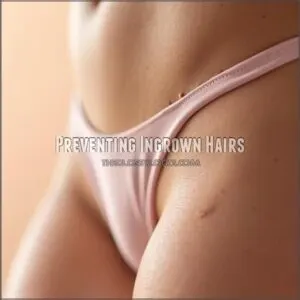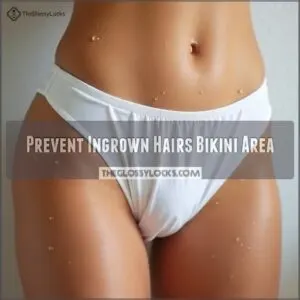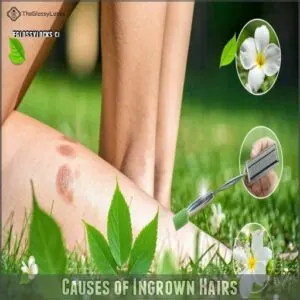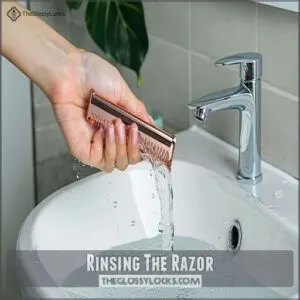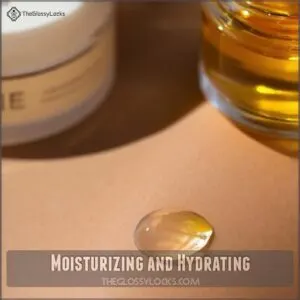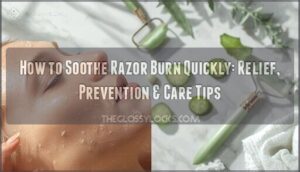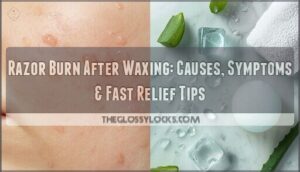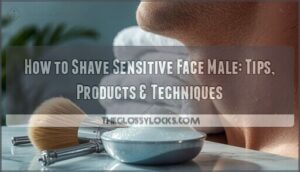This site is supported by our readers. We may earn a commission, at no cost to you, if you purchase through links.

Start by exfoliating 24 hours before shaving using gentle, circular motions—think of it as clearing the path for a smooth journey.
When it’s showtime, soak in warm water for 5-10 minutes, apply an unscented shaving cream, and always shave in the direction your hair grows.
Use a fresh, sharp razor (replace it after 5-7 uses), and don’t press too hard.
After shaving, pat dry and apply an alcohol-free moisturizer. Your skin’s unique characteristics might require some personalized tweaks to this routine.
Table Of Contents
- Key Takeaways
- Preventing Ingrown Hairs
- Prevent Ingrown Hairs Bikini Area
- Causes of Ingrown Hairs
- Shaving Techniques for Prevention
- Alternative Hair Removal Methods
- Post-Shaving Care and Treatment
- Maintaining Healthy Skin
- Frequently Asked Questions (FAQs)
- How do you get rid of ingrown hairs on a bikini?
- What are some ways to prevent ingrown hair?
- How do you prevent ingrown hairs if you shave?
- How do I prevent ingrown hairs after a bikini wax?
- Do you have ingrown hairs around your bikini line?
- Can a shave cause ingrown hairs?
- How to shave pubic hair to avoid ingrown hairs?
- How do I stop ingrown hairs from coming down below?
- Why am I getting so many ingrown hairs on my bikini line?
- How do you permanently prevent ingrown hairs?
- Conclusion
Key Takeaways
- Before shaving, exfoliate your bikini area 24 hours in advance using gentle circular motions to remove dead skin cells and unclog pores, which will help prevent ingrown hairs.
- You’ll want to replace your razor every 5-7 uses and always shave in the direction of hair growth with unscented shaving cream, using light pressure to avoid irritation.
- Don’t go over the same area multiple times while shaving – each pass increases skin irritation and your chance of ingrown hairs, so wait until your next session if you’ve missed a spot.
- After shaving, pat your skin dry and apply an alcohol-free moisturizer, then wear loose cotton clothing for at least 24 hours to let your skin breathe and heal properly.
Preventing Ingrown Hairs
You can prevent those pesky ingrown hairs in your bikini area by following a few simple but effective steps that work with your body’s natural hair growth patterns.
With the right tools and techniques, you’ll reduce irritation and keep your skin smooth, making those uncomfortable bumps and inflammation a thing of the past.
Exfoliating Before Shaving
Your skin’s smooth future starts with a good pre-shave routine. Exfoliating your bikini area helps prevent those pesky ingrown hairs by clearing dead skin cells and unclogging pores. Understanding how to prep skin is important for a comfortable shave.
Here’s your foolproof exfoliation guide:
- Exfoliate 24 hours before shaving to avoid irritation
- Use gentle, circular motions with a mild scrub
- Focus on areas prone to ingrowns
- Never scrub too hard – let the product do the work
Using Sharp Razors
Amid the quest for silky-smooth skin, a dull razor is your worst enemy regarding preventing ingrown hairs in the bikini area.
Replace blades after 5-7 uses to maintain ideal razor sharpness. Sanitize your razor before each use and store it in a dry place.
For ultimate comfort and control, choose a handle with good ergonomics – it’ll make precision shaving easier and help prevent those pesky razor bumps. Using best razors can substantially reduce the occurrence of ingrown hairs in the bikini area.
Shaving in Hair Growth Direction
Now that you’ve got a sharp blade ready, let’s talk about direction. Going with the grain isn’t just old-school wisdom – it’s backed by science.
When you shave in the direction your hair grows, you’ll notice:
- Less tugging and pulling on the hair follicle
- Reduced risk of cuts and irritation
- Better control over your shaving technique
- Smoother results without those pesky ingrown hairs
Feel the direction of growth by running your fingers over the area – if it feels smooth, that’s the way to go, and you’ll achieve smoother results.
Prevent Ingrown Hairs Bikini Area
The bikini area needs extra TLC to prevent those pesky ingrown hairs. Start your hair removal routine by soaking in warm water for 5-10 minutes to soften the skin and hair.
For razor burn prevention, apply a gentle, unscented shaving cream specifically designed for sensitive skin. To prevent ingrown hairs, always use a fresh, sharp razor and shave in the direction your hair grows – going against the grain might seem tempting, but it’s a recipe for skin irritation.
Keep your hair follicle health in check by using light pressure and rinsing your razor after each stroke. After shaving, pat the area dry and apply an alcohol-free moisturizer with soothing ingredients like aloe vera.
Pro tip: wearing cotton underwear helps your skin breathe and reduces friction that can lead to ingrown hairs bikini area.
Causes of Ingrown Hairs
You’re not alone if you’ve noticed those pesky red bumps appearing in your bikini area after hair removal, as factors like your hair type, skin sensitivity, and chosen removal method can all trigger ingrown hairs.
Your natural hair texture, especially if it’s curly or coarse, makes you more likely to develop ingrown hairs because these hair types tend to grow back into the skin rather than straight out.
Curly Hair and Ingrown Hairs
If you’ve got curly hair, you’re more likely to experience ingrown hairs in the bikini area.
Hair texture plays a significant role – tightly coiled strands are prone to growing back into the skin, especially in those with African ancestry.
This condition, known as pseudofolliculitis barbae, occurs because curly hair’s natural spiral pattern makes it easier for the sharp tip to pierce the skin during regrowth.
Skin Type and Ingrown Hairs
Your skin type plays a significant role in developing ingrown hairs bikini area.
Sensitive skin issues make you more prone to irritation and inflammation, while dry skin care requires extra attention to prevent hair from getting trapped.
Oily skin problems can clog pores, increasing ingrown hair risk.
With combination skin challenges, you’ll need targeted treatment for different zones.
Normal skin types aren’t immune either – proper prevention is still key.
Understanding ingrown hair causes is essential to develop an effective prevention strategy.
Ethnicity and Ingrown Hairs
Understanding the role of genetic predisposition in ingrown hairs can be eye-opening. Research shows that racial differences substantially impact your likelihood of developing razor bumps, with Black individuals experiencing higher rates due to naturally curly hair texture.
Hair structure varies across ethnicities, affecting skin sensitivity and ingrown hair prevention needs. Additionally, studies on Asian hair reveal distinct characteristics that influence hair growth and texture.
Cultural practices and hair removal methods should be adapted accordingly for ideal bikini area care.
Shaving Techniques for Prevention
You’ll be amazed at how a few simple shaving techniques can transform your bikini area maintenance routine into a hassle-free experience.
By mastering the right shaving methods, you can greatly reduce your risk of those pesky ingrown hairs that often show up in sensitive areas.
Avoiding Multiple Passes
While it’s tempting to go over the same spot multiple times, each pass of the razor increases skin irritation and your chance of ingrown hairs in the bikini area.
Stick to gentle strokes and avoid dragging the blade repeatedly over sensitive skin.
If you’ve missed a spot, wait until your next shaving session – your hair follicles will thank you for reducing razor friction and giving them time to recover.
Using Lubrication
Now that you’ve minimized those multiple passes, let’s focus on getting the smoothest glide possible.
Your skin needs proper lubrication to protect against irritation. Skip the dry shaving and opt for a quality shaving gel or cream.
Natural oils work too – think coconut or jojoba. Using natural shaving oil can also be beneficial for sensitive skin.
Just remember to apply generously and reapply if the lubricant starts drying out during your shave.
Rinsing The Razor
Did you know proper razor cleaning tips can make or break your bikini area shaving routine? The key to ingrown hair prevention lies in keeping your blade pristine.
Here’s what experts recommend:
- Rinse with warm water after every stroke to remove hair and shaving cream residue
- Clean your razor thoroughly to prevent bacterial growth
- Change blades regularly to avoid irritation
- Use gentle soap to remove stubborn residue
For more information on shaving techniques and best practices, maintaining a clean razor is essential for preventing ingrown hairs.
Consistent blade maintenance protects your sensitive skin.
Alternative Hair Removal Methods
If you’re tired of fighting with razor bumps, you’ll be glad to know there are several effective alternatives to traditional shaving.
From gentle trimming to professional treatments like waxing and laser hair removal, you’ve got options that can help you avoid those pesky ingrown hairs.
While keeping your bikini area smooth.
Trimming and Exfoliating
Trimming and exfoliating offer a gentler approach to hair removal that won’t leave your skin feeling like it’s been through the wringer.
| Method | Benefits | Best Practice |
|---|---|---|
| Gentle Trimming | Reduces Hair Texture | Keep length at 1/4 inch |
| Physical Exfoliant | Removes dead skin cells | Use twice weekly |
| Chemical Exfoliant | Prevents ingrown hairs | Apply post-trim |
To achieve the best way to trim pubic area, consider the tools and techniques that work best for your skin type.
For skin exfoliation that really works, grab a gentle scrub and work in circular motions. Remember: your bikini area’s sensitive, so easy does it with the pressure.
Chemical Hair Removal
Modern chemical hair removal creams give you a gentler way to remove unwanted hair.
Look for formulas with green tea and natural oils that work best for sensitive skin.
The most effective creams contain thioglycolic acid to break down hair proteins, balanced with soothing ingredients like aloe and chamomile.
In-shower options offer extra convenience, but always do a patch test first.
Waxing and Laser Hair Removal
While chemical treatments offer one solution, waxing and laser hair removal provide longer-lasting results for preventing ingrown hairs in your bikini area.
Here’s what you should know about these methods:
- Waxing benefits include removing hair from the root, leading to slower regrowth and fewer sharp tips that cause ingrowns
- Laser hair removal permanently reduces hair growth, though results vary by skin type
- Both methods require professional expertise to minimize skin reactions and guarantee safety
Remember to avoid tight clothing after treatments to let your skin breathe and heal properly.
Post-Shaving Care and Treatment
You’ll need to give your freshly shaved skin some extra TLC to prevent those pesky ingrown hairs from making an unwanted appearance.
Taking care of your skin after shaving isn’t just about slapping on some moisturizer – it’s about using the right products and treatments to keep your bikini area smooth and bump-free.
Moisturizing and Hydrating
Beyond the basic hair removal methods, your skin needs extra TLC. A good moisturizing routine keeps your skin barrier happy and helps prevent those pesky ingrown hairs.
Using a post shave balm can provide essential soothing properties.
Here’s what different moisturizing products can do for you:
| Product Type | Benefits | Best Time to Apply |
|---|---|---|
| Natural Oils | Skin barrier repair | Evening |
| Hydrating Lotions | Quick absorption | Post-shower |
| Aftershave Balms | Soothing properties | Right after shaving |
| Gel Moisturizers | Light hydration | Morning |
| Barrier Creams | Deep moisture | Before bed |
Oral or Topical Antibiotics
Many ingrown hair infections require careful treatment with antibiotics. If you notice signs of bacterial infections like severe redness or swelling, your doctor might prescribe oral antibiotics for deep infections or topical antibiotic creams for surface-level cases.
They’ll determine the right treatment duration based on your skin inflammation severity. Don’t self-prescribe—antibiotic resistance is real, and proper infection prevention starts with professional guidance.
Maintaining Healthy Skin
You’ll need more than just good shaving habits to keep your bikini area free from ingrown hairs.
Taking care of your skin before and after hair removal, including wearing breathable clothing and giving your skin time to recover between sessions, will help prevent those pesky bumps from appearing.
Wearing Loose Clothing
After treating your skin, let’s talk about what you’re wearing – because those skinny jeans might be causing trouble. For sensitive skin shaving bikini areas, your fabric choice matters more than you’d think.
Here’s what works:
- Choose breathable fabrics like cotton for everyday wear
- Skip synthetic materials that trap moisture
- Wear loose-fitting bottoms for at least 24 hours post-shave
- Pack a cotton dress for beach days
Avoiding Over-Shaving
Just like your skin needs breathing room from tight clothes, it needs a break from constant shaving.
To prevent ingrown hairs bikini area, limit your shaving frequency to every 2-3 days. Your skin needs time between sessions for proper hair regrowth and healing.
When you rush back to shaving too quickly, you’re inviting razor burn and skin irritation. Good shave prep means respecting your skin’s recovery time.
Effective shaving prep techniques can greatly reduce the occurrence of ingrown hairs and irritation, allowing for a smoother shaving experience.
Seeking Medical Attention
While minor ingrown hairs usually clear up on their own, don’t hesitate to get medical help if you notice signs of infection.
Schedule a doctor visit if you experience persistent redness, swelling, or pain in your bikini area.
Your dermatologist might recommend prescription treatments like medicated soap or antibiotic cream.
Watch for fever or spreading redness – these warrant emergency care to prevent serious skin infections.
Frequently Asked Questions (FAQs)
How do you get rid of ingrown hairs on a bikini?
Apply a warm compress, gently exfoliate with a washcloth, and use over-the-counter acne medication containing salicylic acid.
Don’t pick or squeeze.
Let the hair grow out naturally while keeping the area clean.
What are some ways to prevent ingrown hair?
You’re fighting a battle against stubborn hairs!
Keep those pesky ingrowns at bay by exfoliating regularly, using sharp razors, shaving in the growth direction, and wearing loose clothes.
Don’t forget to moisturize daily.
How do you prevent ingrown hairs if you shave?
Use a sharp razor, shave in hair growth’s direction, and prep skin with warm water.
Exfoliate regularly, moisturize after, and don’t repeat strokes.
Keep your skin clean and wear loose-fitting clothes.
How do I prevent ingrown hairs after a bikini wax?
Don’t jump the gun after waxing!
For smooth sailing, exfoliate gently starting day 3, keep the area clean, moisturize with lightweight lotion, and wear loose clothing.
A cold compress helps reduce inflammation.
Do you have ingrown hairs around your bikini line?
Ingrown hairs can pop up around your bikini line, especially after hair removal.
They’re those pesky red bumps that form when hair grows back into the skin instead of breaking through naturally.
Can a shave cause ingrown hairs?
Pesky prickly problems arise when you shave.
Your hair can grow back into the skin instead of out, especially when you shave against the grain or use a dull razor blade.
How to shave pubic hair to avoid ingrown hairs?
Shave with warm water and gentle soap, using a sharp single-blade razor. Move with hair growth, never against it. Don’t press too hard.
Apply unscented moisturizer afterward. Wear loose cotton underwear while healing.
How do I stop ingrown hairs from coming down below?
To prevent irritation down there, exfoliate gently before hair removal, use a sharp single-blade razor with shaving cream, and move in the hair’s growth direction.
Moisturize after and wear loose-fitting clothes.
Why am I getting so many ingrown hairs on my bikini line?
Tight clothing, dull razors, or shaving against hair growth can cause ingrown hairs along your bikini line.
Curly or coarse hair types are more prone to ingrown hairs, and dry skin exacerbates the issue.
How do you permanently prevent ingrown hairs?
Ready to bid farewell to pesky ingrown hairs forever?
Try laser hair removal for permanent results.
Or opt for regular exfoliation, always use sharp razors, and maintain proper shaving technique in hair growth’s direction.
Conclusion
Studies show that 60% of people experience ingrown hairs in sensitive areas at some point. By following these expert tips on how to prevent ingrown hairs in your bikini area, you’ll greatly reduce your risk of irritation and infection. Remember, prevention is easier than treatment.
Whether you choose to shave, wax, or try alternative methods, maintaining proper skin care and following the right techniques will help keep your skin smooth and ingrown-free.
Take your time, listen to your skin, and adjust your routine as needed.
- https://www.aafp.org/pubs/afp/issues/2013/0615/p859.html
- https://www.dovepress.com/asian-hair-a-review-of-structures-properties-and-distinctive-disorders-peer-reviewed-fulltext-article-CCID
- https://dermnetnz.org/topics/shaving
- https://www.yahoo.com/lifestyle/read-shaving-pubic-hair-213000164.html
- https://www.healthline.com/health/how-to-handle-ingrown-hair-face

